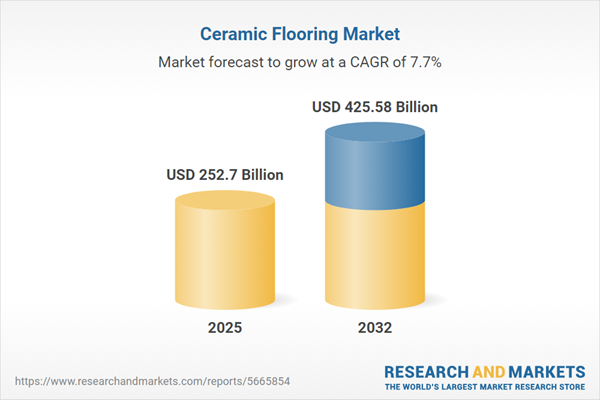Speak directly to the analyst to clarify any post sales queries you may have.
The ceramic flooring market is undergoing a transformation as senior decision-makers prioritize digital adoption, regulatory compliance, and strategic agility. Evolving project requirements and increased operational complexity are driving structured approaches to procurement and supply chain management.
Ceramic Flooring Market Snapshot: Growth and Outlook
The global ceramic flooring market is expanding at a compound annual growth rate (CAGR) of 7.72%. In 2024, market valuation has reached USD 234.71 billion, projected to rise to USD 252.70 billion by 2025, with forward estimates of USD 425.58 billion by 2032. Growth is being realized in residential, commercial, and industrial sectors, underpinned by demand for innovative materials and enhanced procurement strategies. Industry leaders are integrating advanced digital technologies, refining compliance policies, and adopting synchronized operational processes. These adaptations meet dynamic project requirements and respond to an increasingly regulated environment. Strategic flexibility and execution excellence are emerging as critical factors for sustained advantage.
Ceramic Flooring Market: Scope & Segmentation
- Material Types: Ceramic tiles, porcelain, quarry tiles, granite, marble, and slate address specific standards for resilience, compliance, and design flexibility across high-traffic commercial spaces, tailored residential projects, and rigorous industrial applications.
- Surface Finishes: Glazed, matte, polished, and textured surfaces provide varying levels of slip resistance and maintenance needs, supporting distinct safety and visual requirements in diverse project segments.
- Distribution Channels: Manufacturer-direct and e-commerce procurement structures deliver greater agility for purchasing teams by streamlining orders and enhancing supply responsiveness for projects of all sizes.
- End Uses: Offices, hospitality venues, warehouses, industrial facilities, and residential environments drive individual buyer priorities, from durability and low upkeep to meeting advanced certification thresholds.
- Regions: The Americas, Europe, Middle East & Africa, and Asia-Pacific maintain unique regulatory guidelines and purchasing behaviors, requiring focused supplier approaches and region-specific sales tactics.
- Leading Companies: Mohawk Industries, RAK Ceramics PJSC, Grupo Lamosa, Kajaria Ceramics, SCG Ceramics, Porcelanosa Grupo, Somany Ceramics, Grupo Industrial Saltillo, Cersanit SA, and Crossville Inc. are progressing portfolios, innovating logistics, and reinforcing global supply strategies.
Key Takeaways for Senior Decision-Makers
- Embracing digital printing technology and nanotechnology in manufacturing allows organizations to offer differentiated options while adapting swiftly to evolving project specifications and compliance mandates.
- Focused sustainability strategies, including broader use of recycled input materials and resource-efficient manufacturing methods, are aligning company objectives with stakeholder priorities and market expectations.
- Leveraging advanced procurement and workflow automation enhances transparency, controls timelines, and ensures consistent performance from initial sourcing through to project execution.
- Tailored regional strategies are crucial: North American firms value local procurement, European companies seek specialized certifications, and Asia-Pacific participants emphasize production scaling and distribution network optimization.
- Distinct end-user preferences persist—commercial buyers seek assets that minimize maintenance, industrial customers prioritize safety, and residential clients desire innovative and adaptable products for changing lifestyle needs.
- Strengthening collaborative partnerships, from installation to environmentally responsible recycling, contributes to deeper supplier alliances and increased retention across core segments.
Tariff Impact: Navigating Trade Policy and Pricing Realities
Recent shifts in United States tariff policies are prompting companies in the ceramic flooring sector to revisit their supply chain strategies. Many organizations are investing in domestic capacities and diversifying sourcing to regions such as Mexico and Southeast Asia. These measures protect against price volatility and regulatory uncertainty, supporting continuity in delivery schedules and reinforcing fulfillment reliability as trade dynamics evolve.
Methodology & Data Sources
All market insights are based on established industry research, regular monitoring of regulatory updates, and in-depth interviews with manufacturers, distributors, and key end users. Verification processes ensure accuracy, providing senior leaders with a clear overview of trends and operational risks shaping the ceramic flooring sector.
Why This Report Matters
- Procurement and executive teams receive practical guidance for steering transformation, maintaining compliance, and integrating digital solutions in the ceramic flooring market environment.
- Region- and segment-focused intelligence enables organizations to respond efficiently to buyer trends and local regulatory shifts.
- Strategies for balancing sustainability goals and process innovation support organizations in building operational resilience and strengthening competitive positioning.
Conclusion
As regulatory and project dynamics shift, adaptive digital initiatives and purposeful collaboration help organizations achieve reliable project delivery. Strategic alliances and flexible approaches position market participants for steady and resilient growth in ceramic flooring.
Additional Product Information:
- Purchase of this report includes 1 year online access with quarterly updates.
- This report can be updated on request. Please contact our Customer Experience team using the Ask a Question widget on our website.
Table of Contents
3. Executive Summary
4. Market Overview
7. Cumulative Impact of Artificial Intelligence 2025
Companies Mentioned
The companies profiled in this Ceramic Flooring market report include:- Mohawk Industries, Inc.
- RAK Ceramics PJSC
- Grupo Lamosa, S.A.B. de C.V.
- Kajaria Ceramics Limited
- SCG Ceramics Co., Ltd.
- Porcelanosa Grupo, S.A.U.
- Somany Ceramics Limited
- Grupo Industrial Saltillo, S.A.B. de C.V.
- Cersanit S.A.
- Crossville, Inc.
Table Information
| Report Attribute | Details |
|---|---|
| No. of Pages | 182 |
| Published | October 2025 |
| Forecast Period | 2025 - 2032 |
| Estimated Market Value ( USD | $ 252.7 Billion |
| Forecasted Market Value ( USD | $ 425.58 Billion |
| Compound Annual Growth Rate | 7.7% |
| Regions Covered | Global |
| No. of Companies Mentioned | 11 |









